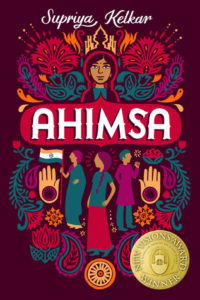Ahimsa by Sypriya Kelka
Guest Post by Padma Venkatraman
Ahimsa, Supriya Kelkar’s New Visions Award winning debut, is set in India in the 1940’s – a time in our shared human history about which enough can never be written.
Ten year old Anjali is growing up in a modern-minded family in India in 1942. Nonetheless, she is shocked to discover that her mother (not father) has decided, with her father’s support, to join Mahatma Gandhi’s Ahimsa (nonviolent) movement to fight for India’s freedom. Anjali is an upper caste Hindu. Irfaan, her best friend – virtually her brother (she has been tying Raakhis on his wrist every year, thus declaring him her brother, which I imagine is hard for anyone who isn’t of South Asian Indian heritage to understand but is very easy for those of us who’ve grown up with this custom to comprehend) – is Muslim. When her mother reaches out (clumsily) to members of the lowest caste in their town, tensions run high. In addition to all this, the prevailing religious and ethnic divisions begin to push Anjali and Irfaan apart. When Anjali’s mother is jailed, Anjali is determined to find a way to bring her back, even if she must do so without the help of her best friend.
Middle grade readers will connect easily with Anjali, the spunky heroine, who is forced to change her lifestyle, confront her privileged upbringing, and question societal prejudices when her mother joins India’s Ahimsa (nonviolent) resistance movement to fight for freedom from British colonialism. Kelkar’s descriptions pay attention to the minutest details, leaving no doubt that readers will be able to visualize the historic setting. She also brings to light an important issue that is often glossed over – the privilege reflected in Mahatma Gandhi’s well meaning, well intentioned and yet at times insensitive treatment of the oppressed “outcasts” in Indian society. Packed with interesting information as this novel is, teachers and librarians will find much in this book to spur thoughtful discussions. Readers are also sure to discover parallels between the desegregation of schools in our nation and the attempt to integrate lower caste children into the Indian education system, as well as the link between Thoreau’s essay on civil disobedience and Mahatma Gandhi’s ideals of nonviolent noncooperation.
I enjoyed reading Ahimsa, a welcome addition to the growing body of South Asian literature for children in the United States.
NOTE: This review was based on an ARC; also note, I provided a blurb for this novel, and part of the wording in this review was used in the blurb.
BIO
Padma Venkatraman is the author of three critically acclaimed novels: A TIME TO DANCE, ISLAND’S END and CLIMBING THE STAIRS, each of which was released to multiple starred reviews. Cumulatively, her books have several awards and been honored with inclusion on over fifty best book lists. Her 4th novel, THE BRIDGE HOME, is about homeless children in India and is scheduled for 2019 Spring release by Nancy Paulsen Books. She enjoys teaching and mentoring and visiting schools and has presented keynote addresses at national and international conferences. Visit her atwww.padmavenkatraman.comand @padmatv.
